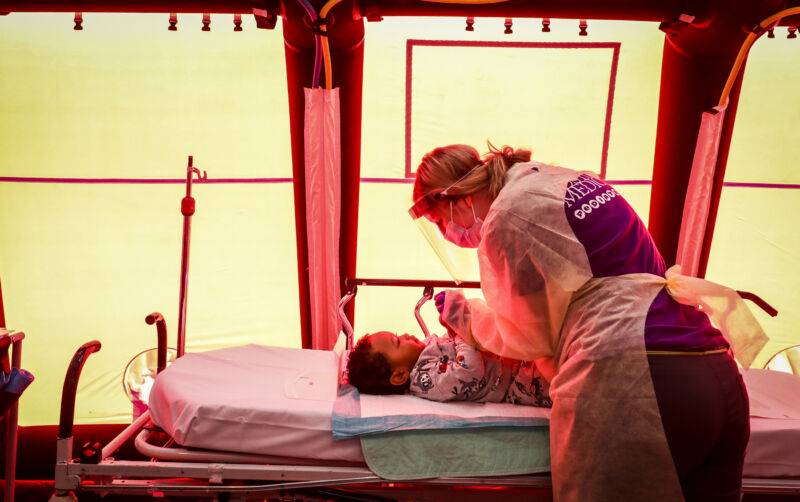
Evidence is stacking up to support a link between COVID-19 and a rare, mysterious inflammatory disease in children, which can be life-threatening.
Though reports of the new disease have trickled in from several countries, many of them have been anecdotal to this point. Now, doctors in an area of Italy hardest hit by the COVID-19 pandemic have published detailed data on a cluster of 10 children who experienced an unusual inflammatory disease amid the outbreak, lending solid support for the link. Their report appeared Wednesday in The Lancet.
The doctors describe the condition they saw as “Kawasaki-like,” referring to a rare disease in children that causes inflammation of blood vessels. Kawasaki disease—identified in Japan in 1967 by Tomisaku Kawasaki—is typically marked by sustained fever, rash, swelling of hands and feet, and swollen lymph nodes in the neck. In the worst cases, it can lead to heart problems and aneurysms.
Despite being identified decades ago, Kawasaki’s cause still remains unclear. Researchers have widely hypothesized that infectious agents—like viruses—trigger berserk immune responses in certain children with genetic predispositions. But no single germy culprit or genetic factors have been firmly nailed down. As such, it’s still unclear who will end up afflicted by the condition. Researchers have only determined that Kawasaki primarily strikes children younger than five, often boys, and often people of Asian and Pacific Island descent.
Since the pandemic began, there have been scattered reports of an uptick in cases of a disease similar to Kawasaki in children. The cases seem linked to outbreaks of COVID-19. However, they don’t always fit the “classic” definitions of Kawasaki.
In the new Lancet study, the Italian doctors offer a clear connection between infection with SARS-CoV-2 and the Kawasaki-like disease. They also lay out in detail how the cases they saw differ from the classic forms of the disease, laying the groundwork for a COVID-19-specific form of the disease.
Surprising spike
To do that, the doctors reviewed medical records of children who were diagnosed with Kawasaki disease between January 1, 2015 and April 20, 2020 at a hospital in Bergamo, Italy. At the time of the study, the city of Bergamo had the highest rate of COVID-19 infections and deaths in Italy, which was ravaged by the pandemic.
The doctors identified only 29 cases in that time frame, 19 of which were diagnosed between January 1, 2015 and Feb 17, 2020. The other 10 were identified between March 17 and April 14, 2020, as the COVID-19 outbreak raged. That spike during the outbreak represents a thirtyfold increase in incidence of the inflammatory condition.
The doctors suspected that all 10 of the Kawasaki cases during the outbreak had been infected with the new coronavirus, SARS-CoV-2, which causes COVID-19. But only eight of the children tested positive for SARS-CoV-2 antibodies, which are Y-shaped proteins made by the immune system to fight off the virus. The presence of the antibodies means that the children had been infected. The doctors suspect that the other two children were false negatives. One, for instance, had received a treatment of immunoglobulin, which may have interfered with the antibody test.
They also noted that previous studies done in 2005 and 2014 had also linked coronaviruses—in these cases, ones that cause seasonal colds—to Kawasaki disease. Though other studies failed to find such a link, the authors argued that, together, “this suggests that the coronavirus family might represent one of the triggers of Kawasaki disease, SARS-CoV-2 being a particularly virulent strain able to elicit a powerful immune response in the host.”
The presence of the virus in nearly all of the cases during the outbreak and the fact that the spike in inflammatory cases “has a clear starting point after the first case of COVID-19 was diagnosed in our area,” convinced the doctors.
“All these results and considerations support the hypothesis that the immune response to SARS-CoV-2 is responsible for a Kawasaki-like disease in susceptible patients,” they concluded.
Mounting mysteries
But the doctors noted that the inflammatory disease was slightly different from the cases seen in the past. The children afflicted during the outbreak tended to be older, with an average age of 7.5, compared with the 19 pre-COVID cases, which had an average age of 3.
The outbreak cases also had more severe diseases. Six of the 10 had heart complications, compared with just two of the 19 cases from the pre-COVID era. Two outbreak cases had signs of toxic shock, which was not seen in any of the earlier cases. Finally, eight of the outbreak cases needed additional steroid treatments to recover, which was only needed in three of the pre-COVID cases.
Ultimately, the doctors were careful to call the cases seen during the outbreak a “Kawasaki-like” disease.
In an accompanying editorial, Russell Viner, president of the Royal College of Paediatrics, and Elizabeth Whittaker, a pediatric infectious diseases expert at Imperial College London, tried to tease this apart. They write: “These differences raise the question as to whether this cluster is Kawasaki disease with SARS-CoV-2 as the triggering agent, or represents an emerging Kawasaki-like disease characterised by multisystem inflammation.”
Like the Italian doctors, they highlight that—however frightening—this inflammatory disease is still rare, likely affecting no more than one in 1,000 children infected with SARS-CoV-2. Parents and doctors should be aware of it but also keep in mind that children are minimally affected by COVID-19 overall.
But, Viner and Whittaker note, that insight into what’s going on with immune responses in this rare condition could help explain other mysteries of the illness.
Understanding this inflammatory phenomenon in children might provide vital information about immune responses to SARS-CoV-2 and possible correlates of immune protection that might have relevance both for adults and children. In particular, if this is an antibody-mediated phenomenon, there might be implications for vaccine studies, and this might also explain why some children become very ill with COVID-19, while the majority are unaffected or asymptomatic.
reader comments
241